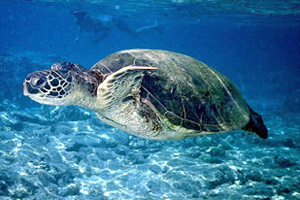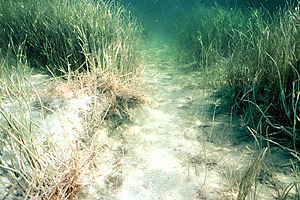Productivity and Shelter
Seagrass provides food and shelter for many marine organisms.

Seagrasses are a primarily food source for many organisms including the manatee (Trichechus manatus) and green sea turtle (Chelonia mydas) both of which are endangered marine herbivores. Many marine species also utilize seagrass habitats as feeding grounds and nursery areas.
Fishes including the tarpon (Megalops atlanticus), snook (Centropomus undecimalis), ladyfish (Elops saurus), crevalle jack (Caranx hippos), and goliath grouper (Epinephelus itajara) forage in seagrass habitats. Gray snapper (Lutjanus griseus), sheepshead (Archosargus probatocephalus), spotted seatrout (Cynoscion nebulosus) and red drum (Sciaenops ocellota) spend their juvenile stage in seagrass habitat, eventually moving on to mangroves as they mature.
Other commercially important species including spiny lobsters (Panulirus guttatus), pink shrimp (Penaeus duorarum) and stone crabs (Menippe mercenaria) also use seagrasses as nurseries.
Sediment Stabilization
Seagrass stabilizes sediments and prevents erosion along Florida’s coastline.

Seagrasses stabilize bottom sediments with their dense roots and rhizomes that form a secure mat. This sediment stabilization and erosion prevention is especially important during storms and hurricanes that often threaten Florida’s coastline.
Water Clarity
Seagrass take up dissolved nutrients and trap sediments in the water resulting in high water clarity.

Seagrasses are efficient at removing dissolved nutrients from waters that often enter coastal waters as a result of runoff from the land. Seagrasses also trap fine sediments and particles from both land and water. The settle out of the water column, becoming trapped among the blades and roots of the seagrasses. The removal of sediments and nutrients from the water results in high water clarity and nutrient-poor waters required for the survival of coral reefs.